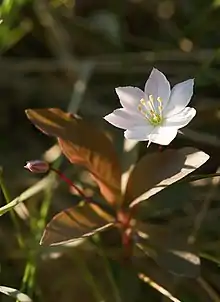Lysimachia europaea
Lysimachia europaea (formerly known as Trientalis europaea) is a flowering plant in the primrose family Primulaceae, called by the common name chickweed-wintergreen[2] or arctic starflower.[3] It is a small herbaceous perennial plant with one or more whorls of leaves on a single slender erect stem.[4] It is about one third of a foot high (10 cm). The broad lanceolate leaves are pale green but take on a copper hue in late summer. The solitary white flowers (1–2 cm, 0.39–0.79 in diameter, usually with 6–8 petals) are reminiscent of small wood anemones and appear in midsummer. The fruits are globular dry capsules but are seldom produced.[5]
| Lysimachia europaea | |
|---|---|
 | |
| Scientific classification | |
| Kingdom: | Plantae |
| Clade: | Tracheophytes |
| Clade: | Angiosperms |
| Clade: | Eudicots |
| Clade: | Asterids |
| Order: | Ericales |
| Family: | Primulaceae |
| Genus: | Lysimachia |
| Species: | L. europaea |
| Binomial name | |
| Lysimachia europaea | |
Lysimachia europaea occurs throughout boreal regions of Europe and Asia, but is absent from eastern North America[6] where it is largely replaced by Lysimachia borealis in corresponding habitats.[7]
This is a woodland indicator species, and in Scotland it is found on acid, organic soils, mainly in pine, birch and oak woodland and moorland which has supported woodland in the past, and also sometimes on heaths. The plant is a good competitor, rarely reproducing by seed but a poor colonist[6] forming extensive clonal populations interconnected by rhizomes during the growing season. The rhizomes and above-ground parts are deciduous, the plant forming overwintering tubers. The range of the plant is changing little in Scotland, but it has declined in northern England due to woodland clearance and moor burning, however its precise distribution on the North York Moors is now better known.[8][6]
The flower is the provincial flower of the Värmland province in Sweden and the "county flower" of Nairn.[8]
Trientalis europaea is now widely referenced in botanical literature under the name Lysimachia europaea.[9]: 551 [1]
References
- "Lysimachia europaea (L.) U.Manns & Anderb". Plants of the World Online. Royal Botanic Gardens, Kew. Retrieved 30 September 2020.
- BSBI List 2007 (xls). Botanical Society of Britain and Ireland. Archived from the original (xls) on 2015-06-26. Retrieved 2014-10-17.
- USDA, NRCS (n.d.). "Trientalis europaea". The PLANTS Database (plants.usda.gov). Greensboro, North Carolina: National Plant Data Team. Retrieved 15 December 2015.
- Taylor, L.K.; Havill, D.C.; Pearson, J.; Woodall, J. (2002) Trientalis europaea. Journal of Ecology 90, 404–418
- McClintock, David; Fitter, R.S.R. (1961). The Pocket Guide to Wild Flowers. Collins. p. 127.
- "Trientalis europaea". Online Atlas of the British and Irish Flora. Botanical Society of Britain and Ireland and Biological Records Centre. Retrieved 22 March 2020.
- "Lysimachia borealis (Raf.) U.Manns & Anderb". Plants of the World Online. Royal Botanical Gardens Kew. Retrieved 20 March 2020.
- "Chickweed wintergreen: Trientalis europaea". Plantlife. Retrieved 20 March 2020.
- Stace, C. A. (2019). New Flora of the British Isles (Fourth ed.). Middlewood Green, Suffolk, U.K.: C & M Floristics. ISBN 978-1-5272-2630-2.